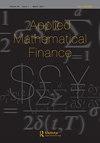多期平均预期缺口策略:“止损乘利”
Q3 Mathematics
引用次数: 2
摘要
动态均值-方差(MV)最优策略本质上是逆向的。在股票回报强劲的时期之后,人们倾向于通过转向无风险投资来降低投资组合的风险。另一方面,如果投资组合中仍有一些股票敞口,那么在股票回报持续低迷之后,股票的权重将会增加。这主要是由于使用方差作为风险度量,它惩罚相对于饱和点的上行和下行偏差。作为替代方案,我们提出了一种基于预期财富(EW)、预期短缺(ES)目标函数的动态交易策略。ES被定义为结果中最差β分数的平均值,因此EW-ES目标直接针对左尾部风险。我们使用随机控制方法来确定最优交易策略。我们的数值方法允许我们施加现实的约束:不使用杠杆,不做空,不频繁的再平衡。对于5年的投资期限,这一策略产生的年化阿尔法值为180个基点,而股票-债券固定权重政策为60:40。用历史数据进行自举重采样表明,这些结果对参数模型错配具有鲁棒性。最优的EW-ES策略通常是动量型策略,与反向的MV最优策略相反。本文章由计算机程序翻译,如有差异,请以英文原文为准。
Multi-Period Mean Expected-Shortfall Strategies: ‘Cut Your Losses and Ride Your Gains’
Dynamic mean-variance (MV) optimal strategies are inherently contrarian. Following periods of strong equity returns, there is a tendency to de-risk the portfolio by shifting into risk-free investments. On the other hand, if the portfolio still has some equity exposure, the weight on equities will increase following stretches of poor equity returns. This is essentially due to using variance as a risk measure, which penalizes both upside and downside deviations relative to a satiation point. As an alternative, we propose a dynamic trading strategy based on an expected wealth (EW), expected shortfall (ES) objective function. ES is defined as the mean of the worst β fraction of the outcomes, hence the EW-ES objective directly targets left tail risk. We use stochastic control methods to determine the optimal trading strategy. Our numerical method allows us to impose realistic constraints: no leverage, no shorting, infrequent rebalancing. For 5 year investment horizons, this strategy generates an annualized alpha of 180 bps compared to a 60:40 stock-bond constant weight policy. Bootstrap resampling with historical data shows that these results are robust to parametric model misspecification. The optimal EW-ES strategy is generally a momentum-type policy, in contrast to the contrarian MV optimal strategy.
求助全文
通过发布文献求助,成功后即可免费获取论文全文。
去求助
来源期刊

Applied Mathematical Finance
Economics, Econometrics and Finance-Finance
CiteScore
2.30
自引率
0.00%
发文量
6
期刊介绍:
The journal encourages the confident use of applied mathematics and mathematical modelling in finance. The journal publishes papers on the following: •modelling of financial and economic primitives (interest rates, asset prices etc); •modelling market behaviour; •modelling market imperfections; •pricing of financial derivative securities; •hedging strategies; •numerical methods; •financial engineering.
 求助内容:
求助内容: 应助结果提醒方式:
应助结果提醒方式:


